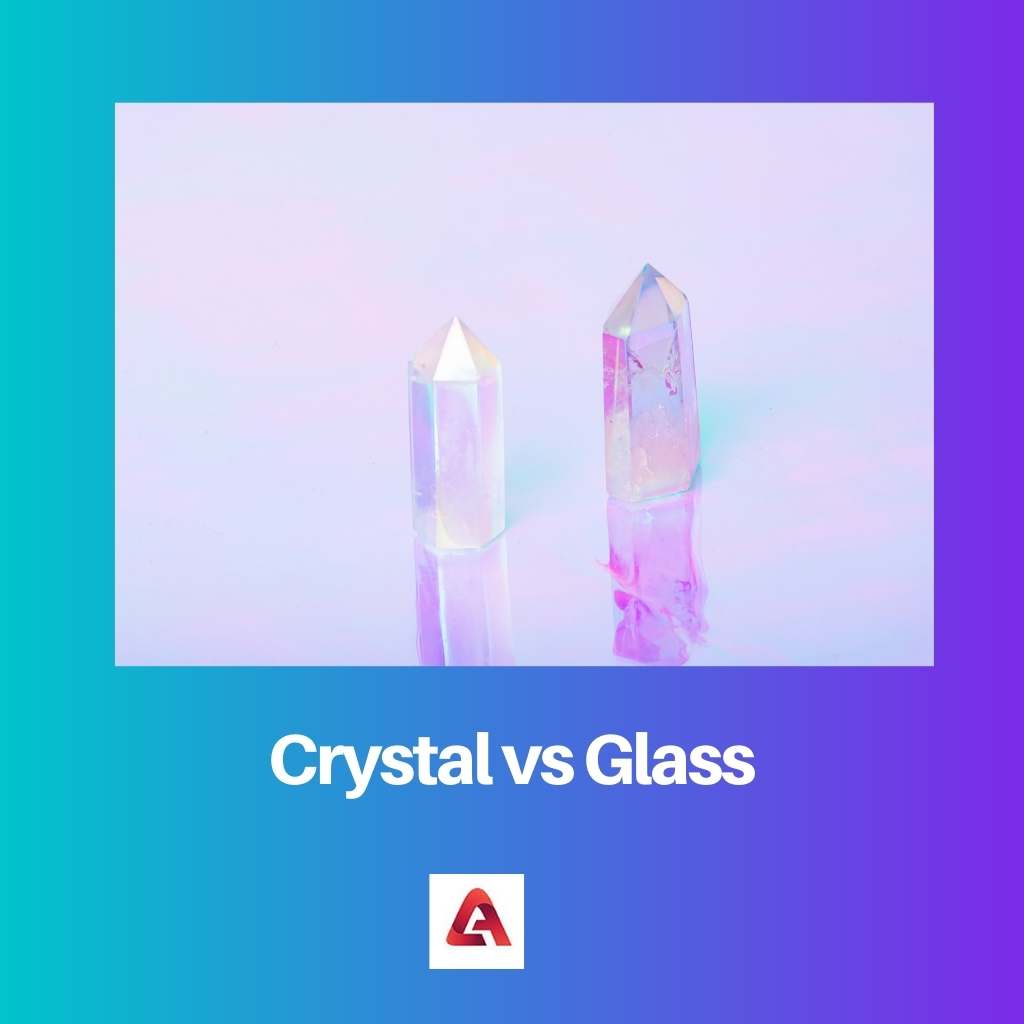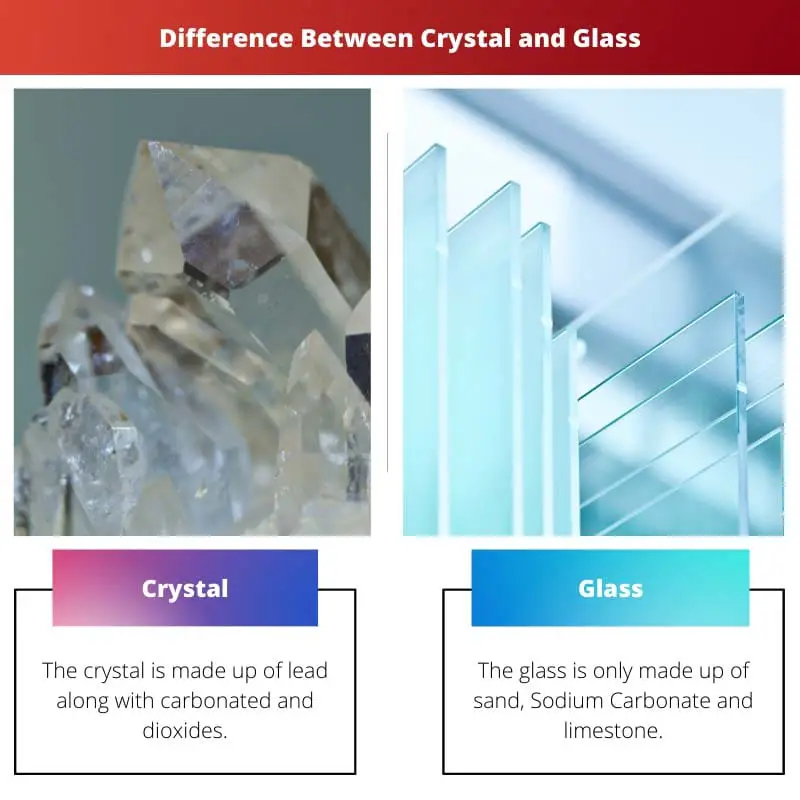Decorations with glass have been very common and show simplicity along with royalty. They can be molded into different shapes, like turtles, bowls, etc.
The two of the most used glassware are crystals and glass. They are used for decoration and also for making things more appealing. They are the basis of each other, and crystal is a sub-group of glass.
Key Takeaways
- Crystals contain lead oxide, making them denser and more refractive than glass, which results in enhanced sparkle and brilliance.
- Glass items require lower temperatures for production and cooling, allowing for faster manufacturing processes than those for crystal items.
- Crystal products exhibit increased durability and resistance to chipping, making them more suitable for intricate designs and luxury items than glass products.
Crystal vs Glass
The difference between Crystal and Glass is that they have different compositions. Glass is made up of Silicon Dioxide or sand, Sodium Carbonate, and limestone or Calcium Carbonate, whereas Crystal contains materials like Carbonates, Dioxides, and especially they contain lead which provides shine and delicate nature to the glass.

Crystal is a solid material in which atoms and molecules are compactly packed and arranged in a highly periodic form that is only available under the microscope.
Crystallography is the study of crystals and crystal formation. Crystal glassware is more famous for its delicacy and is taken out on special occasions.
Glass is very famous worldwide and is a large category that contains all types of pieces. The glass is made up of Calcium, Sodium Carbonate, and Silicon Dioxide.
The mixing of various types of elements leads to the development of sub-categories. The glass is more strong and also has an unbreakable category.
Comparison Table
| Parameters of Comparison | Crystal | Glass |
|---|---|---|
| Composition | The crystal is made up of lead along with carbonated and dioxides. | The glass is only made up of sand, Sodium Carbonate and limestone. |
| Appearance | It is desirable for high-end glassware because it has incredible clarity. | The glass has a tint because of the component that was added like green with iron. Even without addition, it is still slightly foggy. |
| Weight Difference | It is comparatively heavier due to the addition of the lead. | It is comparatively easy to handle because of the lightweight |
| Thickness | The crystal can be shaped thinner because they can be heated at lower temperatures and that provides strength to stretch the glass. | The glass cools down quickly due to the presence of soda-lime and the rim is thicker which provided flexibility |
| Cut | The structure is more polished and buffed without shattering since it is more malleable and is crafted by hands. | The cuts are sharp and brittle because there is very little time or they are put into a mould. |
What is a crystal?
A crystal, according to chemistry, is anything that has a definite shape, and the molecules and atoms are closely packed into a highly ordered or periodic structure.
This structure extends in all directions and forms a microscopic crystal lattice. They can be macroscopic as well, and the structure of a single crystal can identify them.
Crystal glassware is very famous because of the shapes it can create and because the work can be handcrafted. The crystal can be melted at low heat due to the presence of lead and potassium.
Due to this, they are more malleable and can be crafted into many shapes, which are more polished and easy to handle.
Crystals have a thin shape and weigh more than glass due to the presence of lead. The lead and metal content of the material has the property to refract light which forms a rainbow after refracting, making it a good material for high-end glassware.
The crystal also has the property of making ringing sounds which makes it distinguishable.
The crystal has some disadvantages like they are more expensive and not desirable for places where thicker or unbreakable glass is required. They also are not worth places where opacity or translucency is required.

What is glass?
Silicate glass is the most durable and oldest form of glass available in the market. The glasses have a composition that includes Silicon Dioxide, Calcium Carbonate, and Sodium Carbonate, with variations in the different types.
Because of this, they have a slight tint, and they are also used at different places with the tint provided by different elements like blue from iron.
Glass is also known to have sharp cuts because of its property that it cools down very fast and has to be heated to high temperatures and high pressure because they contain a soda-lime mixture.
The glass, after heating, cannot be touched by hands with gloves, so they are put in molds for shaping and have brittle edges.
The glass is less malleable and breaks easily. It is also thicker and stronger when used for tabletops, glasses, etc.
They produce a dull chime when rung that is more subtle and peaceful, the quality of glass to pass light through it gives it unique importance in homes, especially the window panes. Durability is one of the features that make them easy to use daily.
The glass has disadvantages; it is sharp, brittle, and needs proper molds. They cannot be used for making delicate pieces that are more handcrafted; they can be scratched easily, and the cutting is also costly.

Main Differences Between Crystal and Glass
- The crystal is made up of lead, carbonated, and dioxide, whereas the glass does not contain lead as a major component.
- The crystal is desirable for high-end glassware because it has incredible clarity. In comparison, the glass has a tint because of the added component, like green with iron. Even without addition, it is still slightly foggy.
- The crystal is comparatively heavier due to the addition of lead, whereas the glass is comparatively easy to handle because it is lightweight.
- The crystal can be shaped thinner because it can be heated at lower temperatures, and that provides strength to stretch the glass, whereas the glass cools down quickly due to the presence of soda-lime, and the rim is thicker, which provides flexibility.
- The crystal structure is more polished and buffed without shattering since it is more malleable and crafted by hand, whereas the cuts on the glass are sharp and brittle because there is very little time or they are put into a mold.




